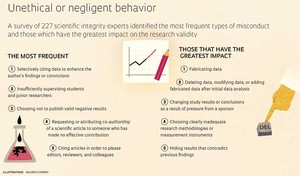 maurício pierroResearchers and institutions are taking steps to prevent the most serious forms of scientific misconduct, such as fraud and data manipulation, but they are not making the same effort to combat questionable or negligent behavior, which can undermine the integrity of research due to the high frequency with which it occurs, even if it does not result in major scandals. To assess the validity of this premise, a group coordinated by psychiatrist Joeri Tijdink, from Vrije Universiteit in Amsterdam, the Netherlands, surveyed 227 experts from various countries who participated in the first four world conferences on research integrity, held between 2007 and 2015.
maurício pierroResearchers and institutions are taking steps to prevent the most serious forms of scientific misconduct, such as fraud and data manipulation, but they are not making the same effort to combat questionable or negligent behavior, which can undermine the integrity of research due to the high frequency with which it occurs, even if it does not result in major scandals. To assess the validity of this premise, a group coordinated by psychiatrist Joeri Tijdink, from Vrije Universiteit in Amsterdam, the Netherlands, surveyed 227 experts from various countries who participated in the first four world conferences on research integrity, held between 2007 and 2015.
The respondents answered an electronic questionnaire that asked for their opinions on a list of 60 different types of unethical or controversial behavior. They assigned points to certain characteristics for each item, such as the severity and regularity with which they occur, resulting in several rankings. The most frequent problem, according to respondents, was a bias that does not necessarily compromise the consistency of a scientific article, where the author selectively cites data that enhances their findings or convictions. Second was a lack of sufficient supervision and guidance for students and junior researchers, which could be caused by neglectful or overworked research leaders.
The biggest problem highlighted by two other rankings, which measured the perceived impact of misconduct on research validity and the trust it inspires, was data fabrication—which is in penultimate place on the list of most frequent issues. In second place was the selective removal, modification, or fabrication of data after initial data analysis, and in third, the manipulation of conclusions due to pressure from a sponsor of the study. Plagiarism was considered common (12th on the list of most frequent problems), but of limited impact (42nd on the list of issues that most impact research validity). “Questionable or undesirable practices, which are sometimes unintentional, can have a greater cumulative impact than cases of fraud,” Tijdink told the Nature Index website.
Some of the common problems, Tijdink notes, are very difficult to eliminate. As an example, he cites the third most frequent problem identified in the survey: researchers choosing not to publish studies when the results were “negative.” Sharing negative results obtained during the research process is important to understanding how representative the positive results are. “But negative results do not generate high-impact journal articles or help fund research. It is difficult to overcome this vicious cycle,” says the psychiatrist.
 The survey was published in the journal Research Integrity and Peer Review at the end of 2016, and was presented at the 5th World Conference on Scientific Integrity in Amsterdam in May. The lead author of the article is epidemiologist Lex Bouter, president of Vrije Universiteit between 2006 and 2013 and one of the organizers of the conference. “It is clear from our research that we need to shift our attention away from the occasional cases of data fabrication and falsification, and toward minor misbehaviors such as statistical rounding and data selection, which are much more frequent,” said Bouter, a scientific methodology and integrity professor, while presenting the survey at the conference.
The survey was published in the journal Research Integrity and Peer Review at the end of 2016, and was presented at the 5th World Conference on Scientific Integrity in Amsterdam in May. The lead author of the article is epidemiologist Lex Bouter, president of Vrije Universiteit between 2006 and 2013 and one of the organizers of the conference. “It is clear from our research that we need to shift our attention away from the occasional cases of data fabrication and falsification, and toward minor misbehaviors such as statistical rounding and data selection, which are much more frequent,” said Bouter, a scientific methodology and integrity professor, while presenting the survey at the conference.
A fourth ranking was produced based on which misconduct issues the participants believed to be most preventable. In first place was the attitude of ignoring risks to study participants, and in second was the tricks used by some researchers that allow them to review their own papers. The study also highlighted differences in perception between different disciplinary fields. According to respondents from the natural sciences, the problem that most compromises research validity in their field is the incorrect rounding of statistical results, while in the biomedical sciences it is the fabrication of data, and in the social sciences it is the possibility of reviewing your own papers.
Research Integrity and Peer Review reviewed the study by Tijdink and Bouter, and were critical of the sample of participants. Of the 1,131 who received the questionnaire, only 227 responded—and this group consisted largely of senior professors and researchers, which could lead to skewed conclusions. The subjective nature of the results—based on the personal opinions of the researchers through a set of 60 predetermined behaviors—was also indicated as a limitation, recognized by the authors. Tijdink argued, however, that it is very difficult to objectively measure the impact of less serious cases of scientific misconduct and explained that surveying the opinions of experts was the best way of assessing the magnitude of the phenomenon. This resource was also used by a study that compared perceptions of scientific integrity among 1,200 biomedical researchers in China in 2015 with those obtained in a survey conducted in 2010.
The paper, published in the journal Science and Engineering Ethics in April, suggests that 40% of the Chinese scientific output in this field is associated with some form of misconduct, but reinforces the idea that less serious types are the most widespread. The most prevalent, according to the Chinese respondents, are plagiarism and improper attribution of authorship to researchers who have not contributed to the published research—well ahead of fraud and fabrication of data.
Scientific articles
BOUTER, L. et al. Ranking major and minor research misbehaviors: Results from a survey among participants of four World Conferences on Research Integrity. Research Integrity and Peer Review. Nov. 21, 2016.
LIAO, Q.-J. et al. Perceptions of Chinese biomedical researchers towards academic misconduct: A comparison between 2015 and 2010. Science and Engineering Ethics. Apr. 10, 2017.